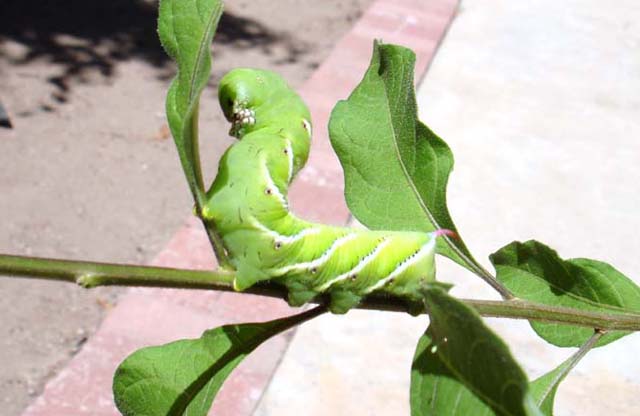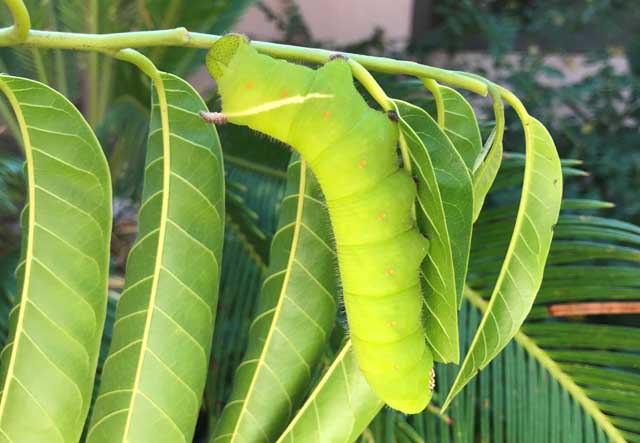Sphingidae Larval Checklist
San Diego County, California

Manduca sexta, August 17, 2007, nearby southern Orange County, California, courtesy of Jessica Cera
|
|
Updated as per James P. Tuttle's The Hawk Moths of North America, September 23, 2009 Updated as per personal communication with Chris Conlan (mature larva, San Diego County, California, 2018); October 23, 2018 |

For care of "found larvae/caterpillars" visit Manduca sexta larva, central Texas, August 21, 2008, Trina Woodall.
It is hoped that this checklist, with the thumbnails and notes, will help you quickly identify the Sphingidae larvae you have encountered.
A WO" after the species name indicates that I have no confirmed reports of this species in San Diego County, but I (William Oehlke) expect that this moth is present.
A USGS indicates the moth is reported on the USGS website and/or in Moths of Western North America, #2. Distribution of Sphingidae of Western North America, revised, an excellent little booklet available through Paul Opler.
This page is inspired by and dedicated to Lauren Westfall for her abiding interest in lepidoptera.
Chris Conlan writes from southern California: "Just thought I would report something rather interesting. I found several larvae of Cocytius antaeus feeding on the cherimoya trees in my backyard and in the yard of a friend who lives about 15 miles west of me. I also had reports of them from another friend last summer who lives several miles to the south but was never able to confirm with actual specimens. Looks like this species may be extending its range into southern California since many folks have backyard cherimoya trees. It also appears they are not really attracted to light as I run a MV light on my back deck most nights of the year and I have gotten many Mexican strays but never seen a Cocytius here until I found those larvae."

Cocytius antaeus final instar, Escondido, San Diego County, California,
on cherimoya, 2018, courtesy of Chris Conlan.
Visit California Catocala: Underwing Moths
If you are travelling, you can find active Sphingidae checklists for all countries in North, Central, and South America and the Caribbbean via the links at North, Central, South American Sphingidae checklists
Sphinginae subfamily
Smerinthini Tribe:
Macroglossinae subfamilyDilophonotini Tribe:
Philampelini Tribe:
Macroglossini Tribe:
|
Enjoy some of nature's wonderments, giant silk moth cocoons. These cocoons are for sale winter and fall. Beautiful Saturniidae moths will emerge the following spring and summer. Read Actias luna rearing article. Additional online help available.
Use your browser "Back" button to return to the previous page.
This page is brought to you by Bill Oehlke and the WLSS. Pages are on space rented from Bizland. If you would like to become a "Patron of the Sphingidae Site", contact Bill.
Please send sightings/images to Bill. I will do my best to respond to requests for identification help.
 Show appreciation for this site by clicking on flashing butterfly to the left. The link will take you to a page with links to many insect sites. |